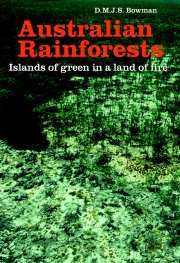Book contents
- Frontmatter
- Contents
- Preface
- 1 Introduction
- 2 What is Australian rainforest?
- 3 The sclerophyll problem
- 4 The edaphic theory I. The control of rainforest by soil phosphorus
- 5 The edaphic theory II. Soil types, drainage, and fertility
- 6 The climate theory I. Water stress
- 7 The climate theory II. Light and temperature
- 8 The fire theory I. Field evidence
- 9 The fire theory II. Fire, nutrient cycling, and topography
- 10 The fire theory III. Fire frequency, succession, and ecological drift
- 11 The fire theory IV. Aboriginal landscape burning
- 12 The fire theory V. Aridity and the evolution of flammable forests
- 13 The fire theory VI. Fire management and rainforest conservation
- 14 Summary
- References
- Index
7 - The climate theory II. Light and temperature
Published online by Cambridge University Press: 23 November 2009
- Frontmatter
- Contents
- Preface
- 1 Introduction
- 2 What is Australian rainforest?
- 3 The sclerophyll problem
- 4 The edaphic theory I. The control of rainforest by soil phosphorus
- 5 The edaphic theory II. Soil types, drainage, and fertility
- 6 The climate theory I. Water stress
- 7 The climate theory II. Light and temperature
- 8 The fire theory I. Field evidence
- 9 The fire theory II. Fire, nutrient cycling, and topography
- 10 The fire theory III. Fire frequency, succession, and ecological drift
- 11 The fire theory IV. Aboriginal landscape burning
- 12 The fire theory V. Aridity and the evolution of flammable forests
- 13 The fire theory VI. Fire management and rainforest conservation
- 14 Summary
- References
- Index
Summary
Introduction
An obvious feature of the boundary between rainforests and adjacent nonrainforest formations is a dramatic change in microclimate. Seddon (1984) suggested that microclimate is often unconsciously used to dichotomise rainforest fromnon-rainforest in Australia. He wrote that rainforests are ‘the only forest form that is at all common in Australia that does cast a dense shade’ being ‘so different from the familiar, light-drenched open forest dominated by eucalypts’ (original emphasis) (Figure 7.1). It has often been assumed that the differences in microclimate are of significance in controlling the establishment of seedlings. Herbert (1932) wrote that ‘in the struggle for existence in the crowded rainforest, sun-loving types, such as Eucalyptus, have no chance of becoming established’. Another factor that changes across the rainforest boundary is ground surface temperature. Minimum temperature and frost are also thought to prohibit subtropical and tropical rainforest from occurring on otherwise optimal sites (Webb and Tracey 1981) and past colder climates may account for the occurrence of grasslands within tracts of subtropical rainforest (Webb 1964). The purpose of this chapter is to:
(i) describe the difference in light across rainforest boundaries;
(ii) evaluate the hypothesis that differences in light regime control regeneration of rainforest and non-rainforest trees;
(iii) consider the effect of maximum and minimum temperature on rainforest distribution.
- Type
- Chapter
- Information
- Australian RainforestsIslands of Green in a Land of Fire, pp. 134 - 155Publisher: Cambridge University PressPrint publication year: 2000



